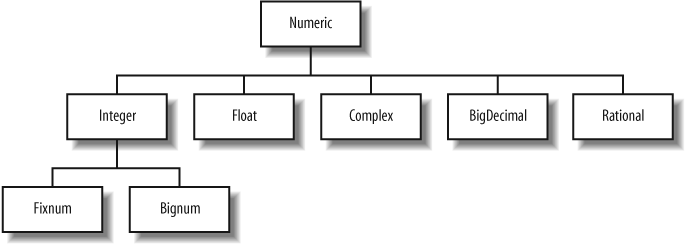Numbers
Ruby includes five built-in classes for representing numbers, and the standard library includes three more numeric classes that are sometimes useful. Figure 3-1 shows the class hierarchy.

Figure 3-1. Numeric class hierarchy
All number objects in Ruby are instances of Numeric. All integers are instances of
Integer. If an
integer value fits within 31 bits (on most implementations), it is an
instance of Fixnum. Otherwise, it is a Bignum.
Bignum objects represent integers of
arbitrary size, and if the result of an operation on Fixnum operands is too big to fit in a
Fixnum, that result is transparently
converted to a Bignum. Similarly, if
the result of an operation on Bignum
objects falls within the range of Fixnum, then the result is a Fixnum. Real numbers are
approximated in Ruby with the Float
class, which uses the native floating-point representation of the
platform.
The Complex class
represents complex numbers, of course. BigDecimal represents
real numbers with arbitrary precision, using a decimal representation
rather than a binary representation. And Rational represents
rational numbers: one integer divided by another. In Ruby 1.8 these
classes are in the standard library. In Ruby 1.9, Complex and Rational are built-in.
All numeric objects are immutable; there are no methods that allow you to change the value held by the object. If you pass a reference to a numeric object to ...
Get The Ruby Programming Language now with the O’Reilly learning platform.
O’Reilly members experience books, live events, courses curated by job role, and more from O’Reilly and nearly 200 top publishers.

